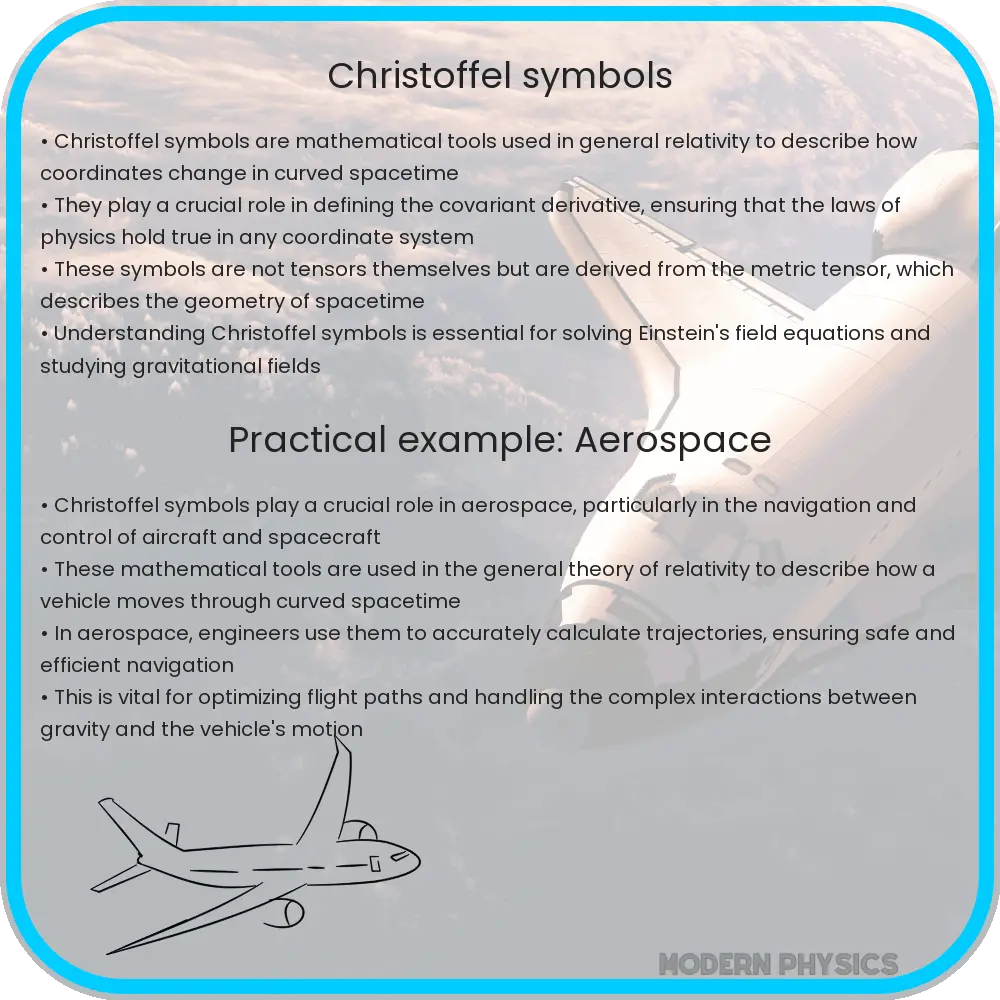Christoffel symbols, essential mathematical expressions in General Relativity, define space-time curvature and coordinate changes.

Understanding Christoffel Symbols in General Relativity
General Relativity, Albert Einstein’s theory that redefined our understanding of gravity, relies on complex mathematics to describe how mass and energy interact with the fabric of space-time. Among these mathematical tools are the Christoffel symbols, which play a crucial role in explaining how objects move in curved space-time. Here, we’ll dive into what Christoffel symbols are and how they are essential to General Relativity.
What are Christoffel Symbols?
Christoffel symbols, named after the German mathematician Elwin Christoffel, are mathematical expressions that appear in the equations of General Relativity. They are used to describe how vectors change as they are moved around in a curved space. Essentially, Christoffel symbols are a set of numbers that help define the curvature of space-time due to the presence of mass and energy.
These symbols are not tensors themselves but rather components of a connection—specifically, the Levi-Civita connection in the context of General Relativity—used to define how the coordinates of a tensor change when moved over space-time.
Role of Christoffel Symbols in General Relativity
In General Relativity, the fundamental concept is that mass and energy curve the fabric of space and time. This curvature affects how objects move and how light propagates. Christoffel symbols enter into the equations that describe these effects, specifically through the geodesic equations which determine the paths that particles and light follow in curved space-time.
The geodesic equation, which defines the shortest or straight-line path in curved space-time, can be expressed as:
d²xˢ / dτ² + Γˢμν dxˢ / dτ dxⁿ / dτ = 0,
where:
- xˢ represents the coordinates of a point in space-time,
- τ is the proper time or the time measured along the path by a clock moving with the particle,
- dxˢ / dτ and dxⁿ / dτ are the derivatives of the coordinates with respect to proper time, showing the velocity at which the coordinates change,
- Γˢμν represents the Christoffel symbols, highlighting their role in connecting space-time coordinates and curvatures.
Calculating Christoffel Symbols
The calculation of Christoffel symbols is fundamental for solving problems in General Relativity. They are derived from the metric tensor—a tensor that defines how distances and angles are measured in a curved space. The relationship between the metric tensor and Christoffel symbols is given by:
Γˢμν = 1/2 gˢρ ( ∂gρμ / ∂xⁿ + ∂gρν / ∂xˢ – ∂gμν / ∂xρ )
Here, gˢρ represents the inverse of the metric tensor, and the partial derivatives of the metric tensor components (gρμ, gρν, gμν) with respect to the coordinates (xρ, xμ, xν) provide the necessary adjustments to account for the curvature created by mass and energy.
This formula shows how the metric tensor’s geometry directly influences the Christoffel symbols, thus impacting how objects experience gravity in the framework of General Relativity. Understanding these symbols is key to delving deeper into the predictive capabilities of General Relativity and how it explains phenomena such as gravitational lensing, orbit dynamics around massive bodies, and the expansion of the universe.
Impact of Christoffel Symbols on Practical Applications
Christoffel symbols not only enrich the theoretical framework of General Relativity but also have practical implications in fields like astrophysics and space exploration. For instance, accurate models of the orbits of planets, satellites, and even light paths near massive objects like black holes require the calculations of Christoffel symbols. These calculations help scientists predict the gravitational lensing effects observed in astronomy which can distort our view of distant galaxies.
Additionally, Global Positioning System (GPS) technology relies on the principles of General Relativity to provide accurate location data. Christoffel symbols are indirectly involved in correcting the time signals sent by satellites to account for the differences in time perception under different gravitational pulls. This ensures that the system remains precise and reliable for global navigation.
Conclusion
Christoffel symbols are essential components in the equations of General Relativity, providing a bridge between abstract mathematical concepts and the physical phenomena resulting from the curvature of space-time. By understanding how these symbols work and affect the motions of objects and light in a curved space, we gain deeper insights into the fundamental nature of gravity and space itself. Moreover, the practical applications of Christoffel symbols in technology and astronomy highlight their importance not only in theoretical physics but also in everyday technological utilities and advanced scientific research.
Whether it’s understanding the universe at a cosmological level or ensuring the accuracy of satellite-based technologies, Christoffel symbols play a crucial role. Thus, delving into General Relativity and its mathematical instruments like the Christoffel symbols not only feeds our curiosity about the universe but also enhances our ability to manipulate and apply this knowledge in various scientific and technological fields.
